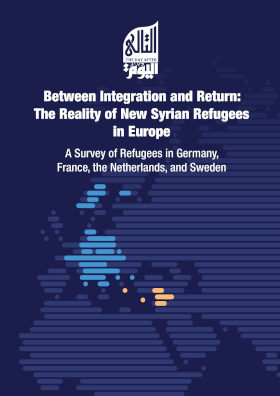 Publication date: January 2021
Publication date: January 2021
View PDF: English / Arabic / Deutsch/ Français
According to UN statistics, almost half the Syrian population has left their homes, first and foremost as a result of violations committed by the Syrian regime, as well as by numerous other parties throughout Syria. The regime is attempting to promote the return of refugees as it continues its violations against civilians inside Syria.
The aim of this study is to shed light on the conditions of refugees in their countries of refuge. The report also attempted to investigate the most important factors that prompted nearly 1.2 million Syrians to seek refuge in 4 European countries: Germany, Sweden, the Netherlands and France – the European countries that received the most Syrian refugees – and to find out how their lives and integration have fared, the most prominent factors affecting their integration, their level of satisfaction with integration policies in each of the four countries, and finally, what they think of returning and the most compelling reasons they may decide not to.
Key research questions included: How well are they integrated into EU countries in general? What are the indicators of integration in each of the target countries? What are the main factors that indicate a strong positive or negative association with integrating refugees into host communities, and how do refugees themselves perceive those societies? And finally, how attached are refugees to their homeland?
The research sample included 1600 respondents who had arrived in Europe since 2011 and spent a year or more in their place of refuge, distributed equally in these 4 countries with 400 in each country. When designing the sample and gathering data, the study was careful to ensure equal representation in terms of gender, age, education, and a balance in sub-categories. Interviews were carried out by a team of 25 qualified young men and women, trained for three days to conduct interviews with the research sample.
Some main findings include:
- Age and length of stay are among the most important factors affecting refugee integration, as well as area of residence in Syria; those coming from hot-zones are less able to integrate due to the psychological effects of regime bombing and violations in general, compared to people coming from areas that did not witness military operations.
- The Corona pandemic has a major negative impact on the ability of recent refugees to integrate and socialize or work, compared to former refugees.
- Results of the study show that the German sample ranks highest of the 4 countries in terms of integration rates, followed closely by the Netherlands sample. In third place is the French sample, where indicators of language and work appear lower, but the willingness and desire of respondents to integrate are high. The Swedish sample’s results appeared to be lower and less consistent, and indicators are troubling, especially in aspects of social communication and relationships between refugees and the host community.
- The majority of Syrian refugees still have a strong connection to their homeland, reflected in the desire of two-thirds of sample respondents to visit Syria if they had the opportunity. On the other hand, two-thirds of the sample refuse to return to settle in Syria.
- Refugees’ decisions to return are directly related to political change in the country that leads to changing some sections of authority; an essential condition for return for most of those who wish to return.